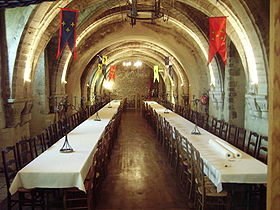
Château de Creully
Encyclopedia



Castle
A castle is a type of fortified structure built in Europe and the Middle East during the Middle Ages by European nobility. Scholars debate the scope of the word castle, but usually consider it to be the private fortified residence of a lord or noble...
located in the town of Creully
Creully
Creully is a commune in the Calvados department in the Basse-Normandie region in northwestern France.The town square is named after Canadian Lieutenant Bill McCormick of the 1st Hussars Canadian Armoured Regiment . Lt...
in the Calvados
Calvados
The French department of Calvados is part of the region of Basse-Normandie in Normandy. It takes its name from a cluster of rocks off the English Channel coast...
département of France.
History
The castle has been modified throughout its history. Around 1050, it did not resemble a defensive fortress but a large agricultural domain. In about 1360, with the Hundred Years War, it was modified into a fortress. During this period, its architecture was demolished and reconstructed with each occupation by the English and the French:- The square tower was built in the 14th century
- A watchtower was added in the 15th century
- Drawbridge in front of the keepKeepA keep is a type of fortified tower built within castles during the Middle Ages by European nobility. Scholars have debated the scope of the word keep, but usually consider it to refer to large towers in castles that were fortified residences, used as a refuge of last resort should the rest of the...
(removed later in 16th century) - Fortification of the walls and demolition of other buildings likely to pose a danger to besieged inhabitants (stables, depots, outside kitchens).
With the end of the war (1450), ownership of the castle returned to baron
Baron
Baron is a title of nobility. The word baron comes from Old French baron, itself from Old High German and Latin baro meaning " man, warrior"; it merged with cognate Old English beorn meaning "nobleman"...
de Creully. It was demolished on the orders of Louis XI
Louis XI of France
Louis XI , called the Prudent , was the King of France from 1461 to 1483. He was the son of Charles VII of France and Mary of Anjou, a member of the House of Valois....
in 1461 through plain jealousy. According to legend, When Louis XI passed through Creully in 1471 he authorised its rebuilding to thank the local people for their warm welcome.
In the 16th and 17th centuries, the barons made modifications:
- Filling of the interior ditch and destruction of the drawbridge
- Construction of a RenaissanceRenaissanceThe Renaissance was a cultural movement that spanned roughly the 14th to the 17th century, beginning in Italy in the Late Middle Ages and later spreading to the rest of Europe. The term is also used more loosely to refer to the historical era, but since the changes of the Renaissance were not...
style turret and large windows - Outbuildings, originally stables, added in 17th
Twenty two barons of the same family had succeeded to the castle between 1035 and 1682. In 1682, the last baron of Creully, Antoine V de Sillans, heavily indebted, sold the castle to Jean-Baptiste Colbert
Jean-Baptiste Colbert
Jean-Baptiste Colbert was a French politician who served as the Minister of Finances of France from 1665 to 1683 under the rule of King Louis XIV. His relentless hard work and thrift made him an esteemed minister. He achieved a reputation for his work of improving the state of French manufacturing...
, minister of Louis XIV
Louis XIV of France
Louis XIV , known as Louis the Great or the Sun King , was a Bourbon monarch who ruled as King of France and Navarre. His reign, from 1643 to his death in 1715, began at the age of four and lasted seventy-two years, three months, and eighteen days...
, who died the following year without living there. Descendants of Colbert occupied Creully until the French Revolution
French Revolution
The French Revolution , sometimes distinguished as the 'Great French Revolution' , was a period of radical social and political upheaval in France and Europe. The absolute monarchy that had ruled France for centuries collapsed in three years...
in 1789, when it was confiscated and sold to various rich landowners.
In 1946, the commune of Creully became the owner of part of the site. The castle's large halls are used today for various events, including weddings, concerts, echibitions and conferences. The site is classified as a monument historique
Monument historique
A monument historique is a National Heritage Site of France. It also refers to a state procedure in France by which national heritage protection is extended to a building or a specific part of a building, a collection of buildings, or gardens, bridges, and other structures, because of their...
.
Second World War
From 7 June 1944, the day after D-DayD-Day
D-Day is a term often used in military parlance to denote the day on which a combat attack or operation is to be initiated. "D-Day" often represents a variable, designating the day upon which some significant event will occur or has occurred; see Military designation of days and hours for similar...
, until 21 July, the square tower housed the BBC
BBC
The British Broadcasting Corporation is a British public service broadcaster. Its headquarters is at Broadcasting House in the City of Westminster, London. It is the largest broadcaster in the world, with about 23,000 staff...
war correspondents and their radio studio, whence the first news of the Battle of Normandy
Operation Overlord
Operation Overlord was the code name for the Battle of Normandy, the operation that launched the invasion of German-occupied western Europe during World War II by Allied forces. The operation commenced on 6 June 1944 with the Normandy landings...
was transmitted.

